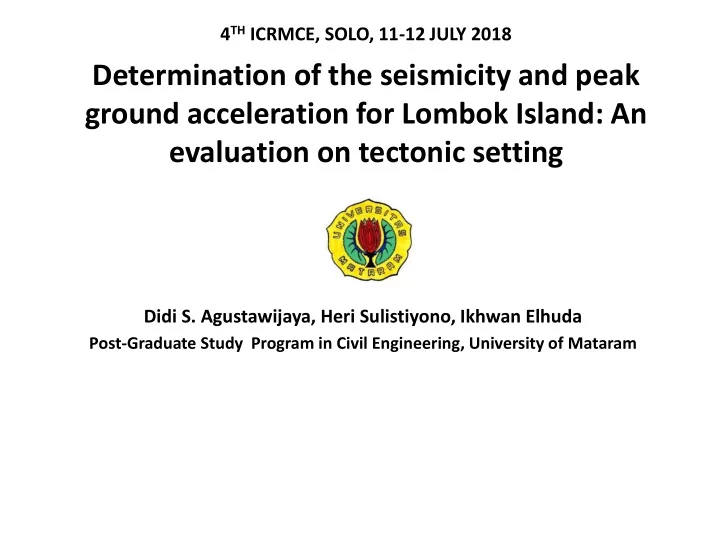

4 TH ICRMCE, SOLO, 11-12 JULY 2018 Determination of the seismicity and peak ground acceleration for Lombok Island: An evaluation on tectonic setting Didi S. Agustawijaya, Heri Sulistiyono, Ikhwan Elhuda Post-Graduate Study Program in Civil Engineering, University of Mataram
INTRODUCTION: TECTONIC OF INDONESIA • Indonesia is one of the most Eurasian plate Pasific plate seismically active parts in the world, due to three tectonic plates collide one to the other, creating seismic events almost every day • Lombok Island is located at the west part of Sunda Arc that Indo- Australian plate subducts beneath Eurasion plate. • Earthquake events around the Sunda Arc island were generated by two seismic sources: southern Lombok subduction mega-thrust and northern back-arc thrust. These two sources fashioned different Indo-Australian plate types of seismic events. The subduction tends to generate deep; conversely the back-arc thrust tends to generate shallow seismic events.
METHODS: 1. To determine the seismicity of Lombok Island, using equations: • Gutenberg-Richter relationship (1949): Log N (M) =a-bM • Likelihood : b = log e / (M ave - M 0 ) • Esteva & Villaverde (1973): PGA = 5600*EXP(0.6Ms)*(R+40) 2 (cm/sec 2 ) • McGuire (1977): PGA = 472.3*10 0.278Ms *(R+25) -1.301 (gal) • Joyner-Boore (1988): PGA=10 ([0.71+0.23(M-6)-Log(r)-0.0027(r)]) (g) 2. The PGA data obtained from three attenuation models were, therefore, plotted on the geological structure map of Lombok Island to reconstruct the tectonic setting of the Island.
RESULTS: DISTRIBUTION OF EARTHQUAKES AROUND LOMBOK ISLAND
RESULTS: CONCENTRATION OF EARTQUAKES AROUND 150 Km of LOMBOK ISLAND 150 • Earthquake events randomly N concentrated on northern part of Lombok Island 100 Distance (km) 50 Lombok 0 -50 -150 -100 -50 0 50 100 150 Distance (km)
DEPTH AND MAGNITUDE OF EARTHQUAKE EVENTS AROUND LOMBOK ISLAND 0 • Earthquake events occurred at depths of 33 - 400 Km 50 • Mostly had a magnitude of >3.0 RS 100 150 Depth (km) 200 250 300 350 400 0 2 4 6 8 Magnitude (RS)
SEISMICITY OF LOMBOK ISLAND 1000 • The a- and b -values: 3.62 and -0.53 • The maximum likelihood of b -value: -0.66 • Category: medium to high seismic events 100 Log Number 10 1 3 4 5 6 7 Magnitude (RS)
PEAK GROUND ACCELARATION OF EARTHQUAKE EVENTS Lombok N • The PGA values are between 0.80 0.003g and 0.11g Esteva-Villaverde • The Esteva-Villaverde 0.70 McGuire produced low PGA Joyner-Boore • The McGuire PGA: 0.01 - 0.60 0.72g • The Joyner-Boore: 0.003 - 0.50 0.28g PGA (g) 0.40 0.30 0.20 0.10 0.00 -50 0 50 100 150 Distance (km)
MAP OF PGA OF LOMBOK ISLAND • The Joyner-Boore equation may indicate the influence of magnitude, distance, and site characterization that is suitable to Lombok Island. • The PGA data were then plotted on the map, in which the maximum PGA data are concentrated on the south-east part of the island.
TECTONIC SETTING OF LOMBOK ISLAND • The tectonic pattern of N Lombok 0 Lombok Island is developed by the south subduction 50 mega-thrust and north Subduction-megathrust Shallow back-arc thrust back-arc thrust, as a consequence of the 100 compression between Australian Continental Plate Depth (km) 150 and Eurasian Plate [1]. • The south subduction tends 200 to produce deep earthquakes; whereas the Subduction-benioff north back-arc thrust tends 250 to produce shallow earthquakes. 300 • The Benioff zone may develop at depths of 150 350 km, similar to the called Benioff-Wadati zone. • The zone may be inclined 400 with an angle of 67 0 -50 0 50 100 150 downward north. Distance (km)
RECONSTRUCTION OF TECTONIC SETTING OF LOMBOK ISLAND Horizontal distance (km) 20 40 60 80 100 120 160 140 0 Northern back arc thurst 100 Depth (km) Southern megathurst 200 Subduction- Benioff 300
CONCLUSION: GEOLOGICAL STRUCTURE OF LOMBOK ISLAND • Lombok Island is categorized into medium to high seismicity. • The attenuation of Joyner- Boore may represent ground motion of seismic Harding’s model event characteristics of the island, since the deep Benioff mixed with shallow back-arc thrust earthquakes dominantly occurred around the island. Rossete diagram • Based on Harding’s tectonic model: Sinistral strike-slip fault may develop on the crustal basement on the direction of NE – SW caused by main horizontal tectonic forces working on the direction of N 171 0 E – N 351 0 E. Alignment N 171 0 E – N 351 0 E Strike-slip fault Force direction
Recommend
More recommend